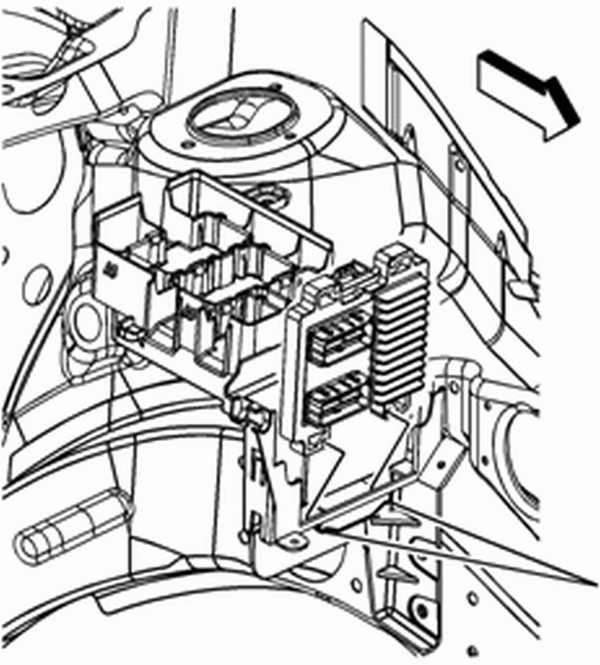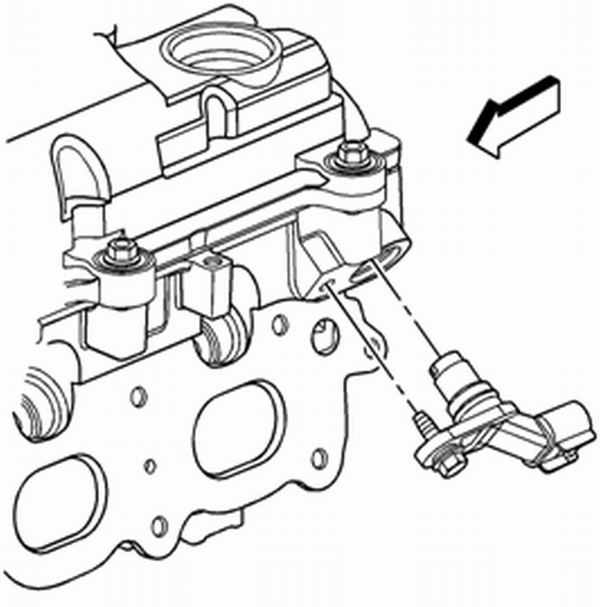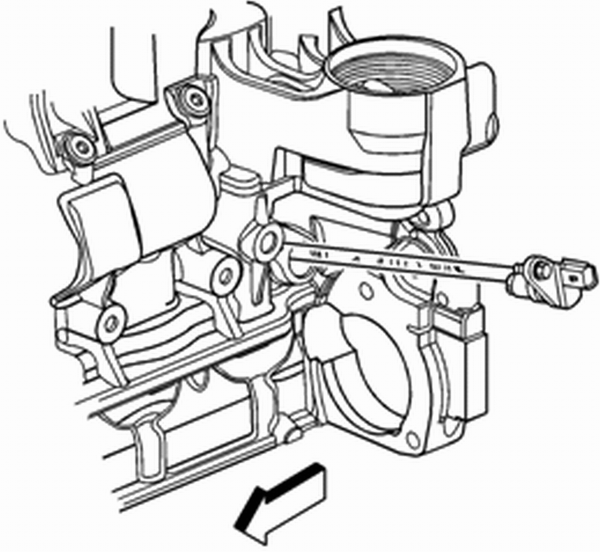Chevrolet Cobalt Service & Repair Manual: Component Service
Engine Control Module (ECM)
| 1. |
Retrieve percentage of remaining engine
oil life using a scan tool, then record remaining engine oil life. |
| 2. |
Remove ECM cover, then disconnect body
wiring harness electrical connector from ECM, Fig. 1. |
| 3. |
Disconnect engine wiring harness from
ECM. |
| 4. |
Release retaining tab and remove ECM
from underhood junction block bracket. |
| 5. |
Reverse procedure to install. |
|
Camshaft Position (CMP) Sensor
Exhaust
| 1. |
Remove engine oil fill cap, then remove
intake manifold cover. |
| 2. |
Disconnect engine wiring harness electrical
connector from CMP sensor. |
| 3. |
Remove exhaust CMP sensor mounting
bolt, then the sensor and O-ring, Fig. 2. |
| 4. |
Reverse procedure to install, noting
the following: |
| |
a. |
Lubricate O-ring seal with clean engine
oil. |
| |
b. |
Torque mounting bolt to 89 inch
lbs. |
|
Intake
| 1. |
Remove engine oil fill cap, then remove
intake manifold cover. |
| 2. |
Disconnect engine wiring harness electrical
connector from CMP sensor. |
| 3. |
Remove intake CMP sensor mounting bolt,
then the sensor and O-ring, Fig. 2. |
| 4. |
Reverse procedure to install, noting
the following: |
| |
a. |
Lubricate O-ring seal with clean engine
oil. |
| |
b. |
Torque mounting bolt to 89 inch
lbs. |
|
Crankshaft Position (CKP) Sensor
| 1. |
Raise and support vehicle. |
| 2. |
Remove starter solenoid terminal nut,
then the positive battery cable terminal from starter. |
| 3. |
Remove starter solenoid wire terminal
from starter. |
| 4. |
Remove starter solenoid "S" terminal
nut. |
| 5. |
Remove engine harness terminal from
the starter. |
| 6. |
Remove starter motor bolts, then the
starter motor. |
| 7. |
Disconnect CKP sensor electrical connector. |
| 8. |
Remove CKP sensor mounting bolt, then
the CKP sensor and O-ring, Fig. 3. |
| 9. |
Reverse procedure to install, noting
the following: |
| |
a. |
Lubricate O-ring with a suitable mineral
based grease. |
| |
b. |
Torque sensor mounting bolt
to 71 inch lbs. |
| |
c. |
Torque starter motor bolts to
30 ft. lbs. |
|
Engine Coolant Temperature (ECT) Sensor
| 1. |
Drain coolant system to below ECT sensor
level. |
| 2. |
Disconnect ECT sensor electrical connector. |
| 4. |
Reverse procedure to install, noting
the following: |
| |
a. |
Coat threads with sealer GM Part No.
12346004, or equivalent. |
| |
b. |
Torque sensor to 89 inch lbs. |
|
Heated Oxygen Sensor (HO2S)
Sensor 1
| 1. |
Remove exhaust manifold heat shield. |
| 2. |
Disconnect HO2S electrical connector. |
| 3. |
Remove HO2S from exhaust manifold. |
| 4. |
Reverse procedure to install, noting
the following: |
| |
a. |
Coat threads of HO2S with anti-seize
compound GM Part No. 12377953, or equivalent. |
| |
b. |
Torque sensor to 22 ft. lbs. |
|
Sensor 2
| 1. |
Raise and support vehicle. |
| 2. |
Remove drive shaft heat shield. |
| 3. |
Disconnect HO2S electrical connector
in engine compartment. Note routing of HO2S electrical harness for
installation reference. |
| 4. |
Carefully bend edge of channel on lefthand
side of exhaust heat shield outboard, just enough to release HO2S
electrical harness. |
| 5. |
Remove HO2S from exhaust pipe, then
carefully lower HO2S electrical harness away from underbody. |
| 6. |
Reverse procedure to install, noting
the following: |
| |
a. |
Coat sensor threads with anti-seize
compound GM Part No. 12377953, or equivalent. |
| |
b. |
Torque sensor to 30 ft. lbs. |
|
Accelerator Pedal Position (APP) Sensor
| 1. |
Remove Connector Position Assurance
(CPA) cover from APP sensor connector. |
| 2. |
Disconnect APP sensor harness connector. |
| 3. |
Remove APP assembly to accelerator
pedal assembly attaching bolts. |
| 4. |
Remove APP assembly from accelerator
pedal. |
| 5. |
Reverse procedure to install. Torque
sensor attaching bolts to 80 inch lbs. |
|
Manifold Absolute Pressure (MAP) Sensor
| 1. |
Remove air cleaner outlet duct. |
| 2. |
Remove intake manifold cover. |
| 3. |
Remove throttle body as outlined under
"Throttle Body." |
| 4. |
Disconnect engine harness electrical
connector from MAP sensor. |
| 5. |
Remove MAP sensor and seal. |
| 6. |
Reverse procedure to install. Lubricate
MAP sensor seal with clean engine oil. |
|
Mass Air Flow/Intake Air Temperature (MAF/IAT) Sensor
| 1. |
Disconnect engine harness electrical
connector from MAF/IAT sensor. |
| 2. |
Remove MAF/IAT sensor retaining screws. |
| 3. |
Remove sensor from air cleaner inlet
duct. |
| 4. |
Reverse procedure to install. |
|
Throttle Body
| 1. |
Remove air cleaner outlet duct. |
| 2. |
Remove intake manifold cover. |
| 3. |
Disconnect throttle actuator control
electrical connector. |
| 4. |
Remove throttle body bolts attaching
bolts, then the throttle body. |
| 5. |
Reverse procedure to install. Torque
throttle body attaching bolts to 89 inch lbs. |
|
Fuel Rail
| 1. |
Relieve fuel system pressure as outlined
under "Precautions." |
| 2. |
Remove air cleaner outlet duct assembly. |
| 3. |
Disconnect fuel line fitting from fuel
rail. |
| 4. |
Disconnect fuel injector harness connectors. |
| 5. |
Remove fuel rail attaching studs. |
| 6. |
Pull fuel rail back and upward to remove
fuel injectors from cylinder head ports. |
| 7. |
Rotate fuel rail to position injectors
downward, then remove fuel rail. |
| 8. |
Reverse procedure to install. Torque
fuel rail studs to 89 inch lbs. |
|
Wiring Harness & Connector Repair
Wiring Connector Repair
| 1. |
Disconnect connector being repaired
from its mating half. |
| 2. |
Cut off existing wire connector directly
behind insulator and remove six inches of tape from harness. |
| 3. |
Stagger cut wires on harness side approximately
one-half inch apart. |
| 4. |
Remove one inch of insulation from
each wire on harness side. |
| 5. |
Stagger cut matching wires on repair
connector in opposite order as was done on harness side of repair.
Ensure overall length is same as original. |
| 6. |
Remove one inch of insulation from
each wire. |
| 7. |
Place piece of heat shrink tubing over
one side of wire. Ensure tubing will be long enough to cover and
seal entire repair area. |
| 8. |
Spread strands of wire apart on each
end of exposed wires. |
| 9. |
Push two ends of wire together until
strands of wire are close to insulation. |
| 10. |
Twist wires together, then solder connection
with rosin core solder. Do not use acid core solder. |
| 11. |
Center heat shrink tubing over joint
and heat using a suitable heat gun. Heat joint until tubing is tightly
sealed and sealant comes out of both ends of tubing. |
| 12. |
Repair wire repair procedure for each
wire on the connector. |
| 13. |
Tape wiring harness starting 11/2 inches
from behind connector and two inches past repair. |
| 14. |
Connect repaired connector. |
|
Wiring Connector Terminal Repair
| 1. |
Disconnect connector being repaired
from its mating half. |
| 2. |
Remove connector locking wedge. |
| 3. |
Position connector locking finger away
from terminal while pulling on wire to remove terminal from connector. |
| 4. |
Cut wire six inches from back of connector,
then remove one inch of insulation from harness side of wire. |
| 5. |
Select wire that best matches wire
being replaced. |
| 6. |
Cut repair wire to correct length and
remove one inch of insulation from end of wire. |
| 7. |
Place piece of heat shrink tubing over
side of wire. Ensure tubing will be long enough to cover and seal
entire repair area. |
| 8. |
Spread strands of wire apart on each
end of exposed wires. |
| 9. |
Push two ends of wire together until
strands of wire are close to insulation. |
| 10. |
Twist wires together, then solder connection
with rosin core solder. Do not use acid core solder. |
| 11. |
Center heat shrink tubing over joint
and heat using a suitable heat gun. Heat joint until tubing is tightly
sealed and sealant comes out of both ends of tubing. |
| 12. |
Insert repaired wire into connector
and install connector locking wedge. |
|
Crankshaft Position (CKP) System Variation Learn
| The Crankshaft Position (CKP)
system variation learn procedure must be performed when any of the following
service procedures have been completed: Engine replacement; control module
replacement; crankshaft balancer replacement; crankshaft replacement; CKP
sensor replacement. |
| 1. |
Install a scan tool and monitor ECM
for DTCs. |
| 2. |
If DTCs other than P0315 are set, diagnose
those codes first. |
| 3. |
With a scan tool, select CKP System
Variation Learn Procedure. |
| 4. |
Block drive wheels and set parking
brake, do not apply brake pedal. |
| 5. |
Cycle ignition from Off to On. |
| 6. |
Apply and hold brake pedal, then start
and idle engine. |
| 7. |
Ensure air conditioning is Off. |
| 8. |
Vehicle must remain in Park or Neutral. |
| 9. |
While learn procedure is in progress,
release throttle immediately when engine starts to decelerate. |
| 10. |
Engine control is returned to operator
and engine responds to throttle position after learn procedure is
complete. |
| 11. |
Accelerate to Wide Open Throttle (WOT)
and release when fuel cut-off occurs. |
| 12. |
If scan tool indicates that DTC P0315
ran and passed, CKP variation learn procedure is complete. |
| 13. |
If scan tool indicates DTC P0315 failed
or did not run, refer to DTC P0315 . |
| 14. |
If any other DTCs set, diagnose DTC. |
| 15. |
Turn OFF ignition for 30 seconds after
learn procedure is completed successfully in order to store CKP
system variation values in ECM memory. |
|

Fig. 1 ECM removal

Fig. 2 CMP sensor removal

Fig. 3 CKP sensor removal
Air Bag Systems
Refer to "Air Bag System Precautions"
on main menu selection for "Precautions."
Battery Ground Cable
Prior to service, disconnect battery ...
See also:
Chevrolet Cobalt Owners Manual. Remote Keyless Entry (RKE) System
The RKE transmitter is used to remotely lock and
unlock the doors from up to 60 m (195 feet) away
from the vehicle.
Press to unlock the
driver door. Press again
within five seconds to
unlock all remaining
doors.
Press to lock all doors.
Lock and unlock feedback can be personalized.
Pre ...
Chevrolet Cobalt Owners Manual
Chevrolet Cobalt Service Manual



 Fuel Injection
Fuel Injection Precautions
Precautions